《儿科学》课程作业习题(试卷和答案)双语试卷B卷(试题)
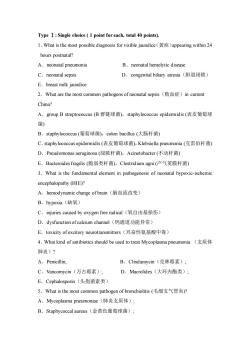
Type I : Single choice (1 point for each, total 40 points)1. What is the most possible diagnosis for visible jaundice(黄疽)appearing within 24hours postnatal?A. neonatal pneumoniaB.neonatal hemolytic diseaseC. neonatal sepsisD.congenital biliary atresia(胆道闭锁)E. breast milk jaundice2. What are thof neonatal sepsis(败血症)in currentChina?A:groupBstreptococcus(B群链球菌),staphylococcus epidermidis(表皮葡萄球菌)B.staphylococcus(葡萄球菌),colon bacillus (大肠杆菌)C.staphylococcusepidermidis(表皮葡萄球菌),Klebsiellapneumonia(克雷伯杆菌)D.Pseudomonas aeruginosa(绿脓杆菌),Acinetobacter(不动杆菌)E.Bacteroidesfragilis(脆弱类杆菌),Clostridium agni(产气荚膜杆菌)3. What is the fundamental element in pathogenesis of neonatal hypoxic-ischemicencephalopathy (HIE)?A.hemodynamic change of brain (脑血流改变)B.hypoxia(缺氧)C.injuriescausedbyoxygenfreeradical(氧自由基损伤)D.dysfunctionofcalcium channel(钙通道功能异常)E.toxicity ofexcitornsmitters(兴奋性氨基酸中毒)4.What kind of antibiotics should be used to treat Mycoplasma pneumonia (支原体肺炎)?A. Penicillin,B.Clindamycin(克林霉素);C.Vancomycin(万古霉素);D.Macrolides(大环内酯类);E.Cephalosporin(头孢菌素类)5.What is the most common pathogen of bronchiolitis(毛细支气管炎)?A.Mycoplasma pneumoniae(肺炎支原体);B.Staphycoccal aureus(金黄色葡萄球菌)
Type Ⅰ: Single choice ( 1 point for each, total 40 points). 1.What is the most possible diagnosis for visible jaundice(黄疸)appearing within 24 hours postnatal? A.neonatal pneumonia B.neonatal hemolytic disease C.neonatal sepsis D.congenital biliary atresia(胆道闭锁) E.breast milk jaundice 2.What are the most common pathogens of neonatal sepsis(败血症)in current China? A.group B streptococcus (B 群链球菌),staphylococcus epidermidis (表皮葡萄球 菌) B.staphylococcus (葡萄球菌),colon bacillus (大肠杆菌) C.staphylococcus epidermidis (表皮葡萄球菌),Klebsiella pneumonia (克雷伯杆菌) D.Pseudomonas aeruginosa (绿脓杆菌),Acinetobacter (不动杆菌) E.Bacteroides fragilis (脆弱类杆菌),Clostridium agni (产气莢膜杆菌) 3.What is the fundamental element in pathogenesis of neonatal hypoxic-ischemic encephalopathy (HIE)? A.hemodynamic change of brain(脑血流改变) B.hypoxia(缺氧) C.injuries caused by oxygen free radical(氧自由基损伤) D.dysfunction of calcium channel(钙通道功能异常) E.toxicity of excitory neurotransmitters(兴奋性氨基酸中毒) 4.What kind of antibiotics should be used to treat Mycoplasma pneumonia (支原体 肺炎)? A.Penicillin; B.Clindamycin(克林霉素); C.Vancomycin(万古霉素); D.Macrolides(大环内酯类); E.Cephalosporin(头孢菌素类) 5.What is the most common pathogen of bronchiolitis (毛细支气管炎)? A.Mycoplasma pneumoniae(肺炎支原体); B.Staphycoccal aureus(金黄色葡萄球菌);
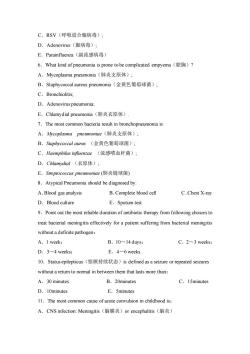
C.RSV(呼吸道合胞病毒)D.Adenovirus(腺病毒);E.Parainfluenza(副流感病毒)6. What kind of pneumonia is prone to be complicated empyema (脓胸)?A.Mycoplasmapneumonia(肺炎支原体);B.Staphycoccal aureus pneumonia(金黄色葡萄球菌)C. Bronchiolitis;D. Adenovirus pneumonia;E.Chlamydial pneumonia(肺炎衣原体)7. The most common bacteria result in bronchopneumonia is:A.Mycoplasmapneumoniae(肺炎支原体);B.Staphycoccalaurus(金黄色葡萄球菌);C.Haemphilus influenzae(流感嗜血杆菌);D.Chlamydial(衣原体)E.Streptococcus pneumoniae(肺炎链球菌)8. Atypical Pneumonia should be diagnosed byA. Blood gas analysisB.Complete blood cellC.Chest X-rayD. Blood cultureE. Sputum test9. Point out the most reliable duration of antibiotic therapy from following choices tctreat bacterial meningitis effectively for a patient suffering from bacterial meningitiswithout a definite pathogen:B. 10~14 days;C. 2~3 weeks;A. I week;D. 3~4 weeks;E. 4~6weeks.10. Status epilepticus (惊厥持续状态) is defined as a seizure or repeated seizureswithout a return to normal in betweecenthemththatlastsmorethan:A.30 minutesB.20minutesC. 15minutesD. 10minutesE.5minutes11. The most common cause of acute convulsion in childhood is:A.CNS infection:Meningitis (脑膜炎)or encephalitis (脑炎)
C.RSV(呼吸道合胞病毒); D.Adenovirus(腺病毒); E.Parainfluenza(副流感病毒) 6.What kind of pneumonia is prone to be complicated empyema(脓胸)? A.Mycoplasma pneumonia(肺炎支原体); B.Staphycoccal aureus pneumonia(金黄色葡萄球菌); C.Bronchiolitis; D.Adenovirus pneumonia; E.Chlamydial pneumonia(肺炎衣原体). 7.The most common bacteria result in bronchopneumonia is: A.Mycoplasma pneumoniae(肺炎支原体); B.Staphycoccal aurus (金黄色葡萄球菌); C.Haemphilus influenzae (流感嗜血杆菌); D.Chlamydial (衣原体); E.Streptococcus pneumoniae (肺炎链球菌) 8.Atypical Pneumonia should be diagnosed by: A.Blood gas analysis B.Complete blood cell C.Chest X-ray D.Blood culture E.Sputum test. 9.Point out the most reliable duration of antibiotic therapy from following choices to treat bacterial meningitis effectively for a patient suffering from bacterial meningitis without a definite pathogen: A.1 week; B.10~14 days; C.2~3 weeks; D.3~4 weeks; E.4~6 weeks. 10.Status epilepticus(惊厥持续状态)is defined as a seizure or repeated seizures without a return to normal in between them that lasts more than: A.30 minutes B.20minutes C.15minutes D.10minutes E.5minutes 11.The most common cause of acute convulsion in childhood is: A.CNS infection: Meningitis(脑膜炎)or encephalitis(脑炎)
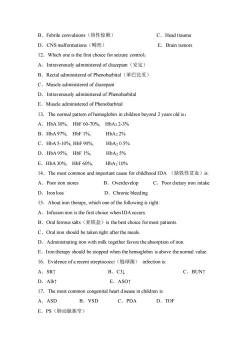
B.Febrile convulsions(热性惊厥)C. Head traumaD. CNS malformations (畸形)E. Brain tumors12. Which one is the first choice for seizure control:A.Intravenously administered of diazepam (安定B.Rectal administered of Phenobarbital (苯巴比妥)C. Muscle administered of diazepamD. Intravenously administered of PhenobarbitalE. Muscle administered of Phenobarbital13. The normal pattern of hemoglobin in children beyond 2 years old is:A.HbA30%,HbF60-70%,HbA22-3%B. HbA97%, HbF 1%,HbA2 2%HbA20.5%C. HbA 5-10%, HbF 90%,HbA2 5%D. HbA95%, HbF 1%,E. HbA30%,HbF 60%,HbA2 10%14.The most common and important cause for childhoodIDA(缺铁性贫血)isA. Poor iron storesB. OverdevelopC. Poor dietary iron intakeD. Iron lossD. Chronic bleeding15. About iron therapy, which one of the following is rightA. Infusion iron is the first choice when IDA occursB. Oral ferrous salts (亚铁盐) is the best choice formost patients.C. Oral iron should be taken right after the meals.D. Administrating iron with milk together favors the absorption of iron.E. Iron therapy should be stopped when the hemoglobin is above the normal value16.Evidence ofa recent streptococci(链球菌)infection is:A. SRB. C31C. BUNTD. Alb↑E. ASO↑17.Themost commoncongenitalheartdiseaseinchildreniA. ASDB. VSDC. PDAD.TOFE.PS(肺动脉狭窄)
B.Febrile convulsions(热性惊厥) C.Head trauma D.CNS malformations(畸形) E.Brain tumors 12.Which one is the first choice for seizure control: A.Intravenously administered of diazepam(安定) B.Rectal administered of Phenobarbital(苯巴比妥) C.Muscle administered of diazepam D.Intravenously administered of Phenobarbital E.Muscle administered of Phenobarbital 13.The normal pattern of hemoglobin in children beyond 2 years old is: A.HbA 30%, HbF 60-70%, HbA2 2-3% B.HbA 97%, HbF 1%, HbA2 2% C.HbA 5-10%, HbF 90%, HbA2 0.5% D.HbA 95%, HbF 1%, HbA2 5% E.HbA 30%, HbF 60%, HbA2 10% 14.The most common and important cause for childhood IDA (缺铁性贫血)is: A.Poor iron stores B.Overdevelop C.Poor dietary iron intake D.Iron loss D.Chronic bleeding 15.About iron therapy, which one of the following is right: A.Infusion iron is the first choice when IDA occurs. B.Oral ferrous salts(亚铁盐)is the best choice for most patients. C.Oral iron should be taken right after the meals. D.Administrating iron with milk together favors the absorption of iron. E.Iron therapy should be stopped when the hemoglobin is above the normal value. 16.Evidence of a recent streptococci(链球菌) infection is: A.SR↑ B.C3↓ C.BUN↑ D.Alb↑ E.ASO↑ 17.The most common congenital heart disease in children is: A.ASD B.VSD C.PDA D.TOF E.PS(肺动脉狭窄)
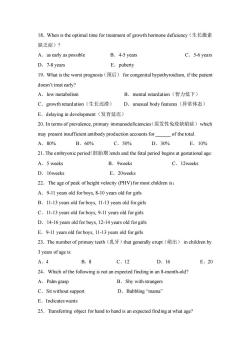
18. When is the optimal time for treatment of growth hormone deficiency (生长激素缺乏症)?A. as early as possibleB. 4-5 yearsC. 5-6 yearsD. 7-8 yearsE. puberty19. Whatis the worst prognosis (预后)for congenital hypothyroidism, fthe patientdoesn't treat early?B.mental retardation(智力低下)A.lowmetabolismC. growth retardation (生长迟滞)D.unusual body features (异常体态)E.delaying in development(发育延迟)20.In terms of prevalence,primary immunodeficiencies(原发性免疫缺陷症)whichmaypresent insufficientantibodyproduction accounts forof the totalA. 80%B. 60%C. 50%D. 30%E.10%21. The embryonic period(胚胎期)ends and the fetal period begins at gestational age:C. 12weeksA.5weeksB. 9weeksD. 16weeksE.20weeks22. The age of peak of height velocity (PHV)for most children is:A. 9-11 years old for boys, 8-10 years old for girlsB. 11-13 years old for boys, 11-13 years old for girlsC. 11-13 years old for boys, 9-11 years old for girlsD. 14-16 years old for boys, 12-14 years old for girlsE. 9-11 years old for boys, 11-13 years old for girls23.The number of primaryteeth(乳牙)that generally erupt(萌出)in childrenby3 years of age is:B. 8D. 16E. 20A. 4C. 1224. Which ofthe following is not an expected finding in an 8-month-old?A. Palm graspB. Shy with strangersD. Babbling"'mama"C. Sit without supportE. Indicates wants25. Transferring object for hand to hand is an expected finding at what age?
18.When is the optimal time for treatment of growth hormone deficiency(生长激素 缺乏症)? A.as early as possible B.4-5 years C.5-6 years D.7-8 years E.puberty 19.What is the worst prognosis(预后) for congenital hypothyroidism, if the patient doesn’t treat early? A.low metabolism B.mental retardation(智力低下) C.growth retardation(生长迟滞) D.unusual body features(异常体态) E.delaying in development(发育延迟) 20.In terms of prevalence, primary immunodeficiencies(原发性免疫缺陷症)which may present insufficient antibody production accounts for _ of the total. A.80% B.60% C.50% D.30% E.10% 21.The embryonic period(胚胎期)ends and the fetal period begins at gestational age: A.5 weeks B.9weeks C.12weeks D.16weeks E.20weeks 22.The age of peak of height velocity (PHV) for most children is: A.9-11 years old for boys, 8-10 years old for girls B.11-13 years old for boys, 11-13 years old for girls C.11-13 years old for boys, 9-11 years old for girls D.14-16 years old for boys, 12-14 years old for girls E.9-11 years old for boys, 11-13 years old for girls 23.The number of primary teeth(乳牙)that generally erupt(萌出) in children by 3 years of age is: A.4 B.8 C.12 D.16 E.20 24.Which of the following is not an expected finding in an 8-month-old? A.Palm grasp B.Shy with strangers C.Sit without support D.Babbling “mama” E.Indicates wants 25.Transferring object for hand to hand is an expected finding at what age?

A. 3 monthsB. 5monthsC. 7monthsD. 9monthsE. 11 months26.Which of the following is ncto four months ofage?A.Posterior fontanel (后窗) closesB. Transfers objects from one hand to the otherC. Decrease in head lag when pulled to sitD. Follows objects 180 degreesE. Smiles to others responsively27. Based on an infants caloric requirements, how many calories per day does a8-month-old who weights 10 kg require?A.950kcalB. 1200kcalC. 1100kcalD. 800kcalE.850kcal28. A 10-week-old child weight 5kg is being fed commercial infant formula (市售婴儿配方奶)Themotherisconceed sheisunderfeedingherbabyYoutell herthat,tosatisy both hisfluid and calorc requirements, thedaily intake oughtobe atleast: (formulas contain 500cal/100g)A.450mlB.550mlC.650mlD.750mlE.850ml29.ThetypicalchangesofCerebrospinalFluid(脑脊液)inchildren withTBM(结核性脑膜炎)include(s):A.Cells:50-500cells/mm3,Mononuclear cell predominance.Glucose and Chloridatlow, high protein level normalB. Cells:50-500cells/mm3, Mononuclear cell predominance. Glucose and Chloridatelow, high protein level with 1-3g/lC. Cells: 50-500cells/mm3, Mononuclear cell predominance. Glucose and Chloridatelow, high protein normal,D. Cells: 20-200cells/mm3, Mononuclear cell predominance. Glucose and Chloridatelow,high protein level with1-3g/LE. Cells: 5000-10000cells/mm3, Mononuclear cell predominance. Glucose and
A.3 months B.5 months C.7 months D.9 months E.11 months 26. Which of the following is not an expected milestone during two to four months of age? A.Posterior fontanel(后囟)closes B.Transfers objects from one hand to the other C.Decrease in head lag when pulled to sit D.Follows objects 180 degrees E.Smiles to others responsively 27.Based on an infants caloric requirements, how many calories per day does a 8-month-old who weights 10 kg require? A.950kcal B.1200kcal C.1100kcal D.800kcal E.850kcal 28.A 10-week-old child weight 5kg is being fed commercial infant formula(市售 婴儿配方奶). The mother is concerned she is underfeeding her baby. You tell her that, to satisfy both his fluid and caloric requirements, the daily intake ought to be at least: (formulas contain 500cal/100g) A.450ml B.550ml C.650ml D.750ml E.850ml 29.The typical changes of Cerebrospinal Fluid(脑脊液)in children with TBM (结 核性脑膜炎)include(s): A.Cells: 50-500cells/mm3, Mononuclear cell predominance. Glucose and Chloridate low, high protein level normal; B.Cells:50-500cells/mm3, Mononuclear cell predominance. Glucose and Chloridate low; high protein level with 1-3g/L; C.Cells: 50-500cells/mm3, Mononuclear cell predominance. Glucose and Chloridate low, high protein normal; D.Cells: 20-200cells/mm3, Mononuclear cell predominance. Glucose and Chloridate low, high protein level with 1-3g/L; E.Cells: 5000-10000cells/mm3, Mononuclear cell predominance. Glucose and
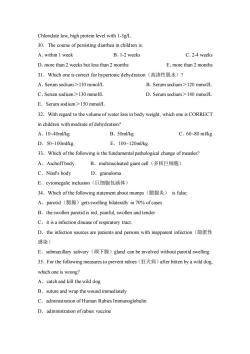
Chloridate low, high protein level with 1-3g/L30. The course of persisting diarrhea in children isA. within I weekB.1-2 weeksC.2-4 weeksD. more than 2 weeks but lessthan 2 monthsE. more than 2 months31.Which oneiscorect forhypertonic dehydration (高渗性脱水)?A. Serum sodium>110 mmol/LB. Serum sod ium>120 mmol/LD. Serum sodium>140 mmo/LC. Serum sodium>130 mmol/LE. Serum sodium>150 mmol/L32. With regard to the volume of water lossin body weight, which one is CORRECTin children with modrate of dehydration?A. 10~40ml/kgB. 50ml/kgC. 60~80 ml/kgD.50~100ml/kgE.100~120ml/kg33. Which ofthe following is the fundamental pathological change of measles?A. Aschoff body.B.multinucleated giant cell(多核巨细胞)C. Niss's bodyD. granulomaE.cytomegalic inclusion(巨细胞包涵体)34. Which ofthe following statement about mumps(腮腺炎)is false:A.parotid(腮腺)gets swelling bilaterally in 70% of casesB. the swollen parotid is red, painful, swollen and tender.itisainfectiondiseaseofrespiatorytract.D. the infection sources are patients and persons with inapparent infection (隐性感染)E. submaxillary salivary (颌下腺)gland can be involved without parotid swelling35. For the following measures to prevent rabies (狂犬病) after bitten by a wild dog.which one is wrong?A. catch and kill the wild dogB. suture and wrap the wound immediatelyC. administration of Human Rabies ImmunoglobulinD.administration of rabies vaccine
Chloridate low, high protein level with 1-3g/L. 30.The course of persisting diarrhea in children is: A.within 1 week B.1-2 weeks C.2-4 weeks D.more than 2 weeks but less than 2 months E.more than 2 months 31.Which one is correct for hypertonic dehydration(高渗性脱水)? A.Serum sodium>110 mmol/L B.Serum sodium>120 mmol/L C.Serum sodium>130 mmol/L D.Serum sodium>140 mmol/L E.Serum sodium>150 mmol/L 32.With regard to the volume of water loss in body weight, which one is CORRECT in children with modrate of dehydration? A.10~40ml/kg B.50ml/kg C.60~80 ml/kg D.50~100ml/kg. E.100~120ml/kg. 33.Which of the following is the fundamental pathological change of measles? A.Aschoff body. B.multinucleated giant cell(多核巨细胞) C.Nissl's body D.granuloma E.cytomegalic inclusion(巨细胞包涵体) 34.Which of the following statement about mumps(腮腺炎) is false: A.parotid(腮腺)gets swelling bilaterally in 70% of cases B.the swollen parotid is red, painful, swollen and tender C.it is a infection disease of respiratory tract. D.the infection sources are patients and persons with inapparent infection(隐匿性 感染) E.submaxillary salivary(颌下腺)gland can be involved without parotid swelling 35.For the following measures to prevent rabies(狂犬病)after bitten by a wild dog, which one is wrong? A.catch and kill the wild dog B.suture and wrap the wound immediately C.administration of Human Rabies Immunoglobulin D.administration of rabies vaccine
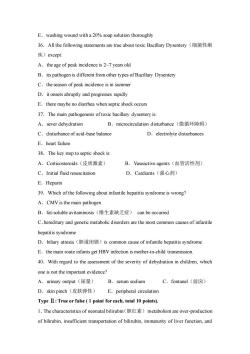
E. washing wound with a 20% soap solution thoroughly36.Allthefollowing statementsaretrueabouttoxicBacilaryDysentery(细菌性疾)exceptA. the age of peak incidence is 2-7 years oldB.its pathogenisdierent fromothertypes ofBacllary DysenteryC. the season of peak incidence is in summeD.itonsetsabruptly and progesses rapidlyE. there maybe no diarrhea when septic shock occurs37.The main pathogenesis oftoxic bacillary dysentery is:B.microciculation disturbance(微循环障碍)A. sever dehydrationC. disturbance of acid-base balanceD. electrolyte disturbancesE. heart failure38.Thekey steptoseptic shockis:A.Corticosteroids(皮质激素)B.Vasoactiveagents(血管活性剂)C. Initial fluid resuscitationD.Cardiants (强心剂)E. Heparin39.Whichofthefllowing about infantlehepatitis syndrome is wrong?A. CMV is the main pathogenB.fat-soluble avitaminosis(维生素缺乏症)can be occurredC. hereditary and genetic metabolic disorders are the most common causes of infantilehepatitis syndromeD.biliary atresia(胆道闭锁)is common cause of infantile hepatitis syndromeE. the main route infants get HBV infection is mother-to-child transmission40. With regard to the assessment of the severity of dehydration in children, whichOne is not the important evidence?A.urinary output(尿量)C. fontanel (前卤)B. serum sodiumD.skinpinch(皮肤弹性)E. peripheral circulationType I : True or false (1 point for each, total 10 points).1.The characteristics of neonatal bilirubin(胆红素)metabolism are over-productionfbirubin, ufficient tranotationofbilirubin, mmaturylverfunion and
E.washing wound with a 20% soap solution thoroughly 36.All the following statements are true about toxic Bacillary Dysentery(细菌性痢 疾)except: A.the age of peak incidence is 2~7 years old B.its pathogen is different from other types of Bacillary Dysentery C.the season of peak incidence is in summer D.it onsets abruptly and progresses rapidly E.there maybe no diarrhea when septic shock occurs 37.The main pathogenesis of toxic bacillary dysentery is: A.sever dehydration B.microcirculation disturbance(微循环障碍) C.disturbance of acid-base balance D.electrolyte disturbances E.heart failure 38.The key step to septic shock is: A.Corticosteroids(皮质激素) B.Vasoactive agents(血管活性剂) C.Initial fluid resuscitation D.Cardiants(强心剂) E.Heparin 39.Which of the following about infantile hepatitis syndrome is wrong? A.CMV is the main pathogen B.fat-soluble avitaminosis(维生素缺乏症) can be occurred C.hereditary and genetic metabolic disorders are the most common causes of infantile hepatitis syndrome D.biliary atresia(胆道闭锁)is common cause of infantile hepatitis syndrome E.the main route infants get HBV infection is mother-to-child transmission. 40.With regard to the assessment of the severity of dehydration in children, which one is not the important evidence? A.urinary output(尿量) B.serum sodium C.fontanel(前囟) D.skin pinch(皮肤弹性) E.peripheral circulation Type Ⅱ: True or false ( 1 point for each, total 10 points). 1.The characteristics of neonatal bilirubin(胆红素)metabolism are over-production of bilirubin, insufficient transportation of bilirubin, immaturity of liver function, and
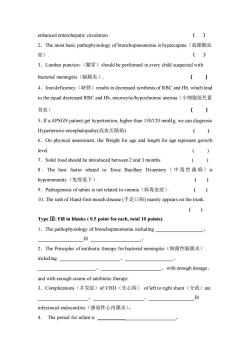
enhancedenterohepatic circulatior2.The most basic pathophysiology of bronchopneumonia is hypercapnia(高碳酸血症)3. Lumbar puncture (腰穿) should be performed in every child suspected withbacterial meningitis(脑膜炎)(4.Irondeficiency(缺铁)resultsindecreasedsynthesisofRBCandHb,whichleadia.(小细胞低色素tothe equal decreaB贫血)(>5. If a APSGN patient get hypertention, higher than 150/120 mmHg, we can diagnosisHypertensivive encephalopathy(高血压脑病)6. On physical assessment, the Weight for age and length for age represent growthlevel.7. Solid food should be introduced between 2 and 3 months。The host factor related to Toxic Bacillary Dysentery(中毒性菌痢)ishypoimmunity(免疫低下),9. Pathogenesis of rabies is not related to viremia (病毒血症)L-10. The rash of Hand-foot-mouth disease (手足病) mainly appears on the trunnType II: Fill in blanks ( 0.5 point for each, total 10 points).1.Thepathophysiology of bronchopneumonia including2.The Principles of antibiotic therapy for bacterial meningitis (细菌性脑膜炎)includ ing:with enough dosage.and with enough course of antibiotic therapy3.Complications(并发症)of CHD(先心病)of lefto right shunt (分流)are和infectiousl endocarditis(感染性心内膜炎)。4. The period for infant is
enhanced enterohepatic circulation. ( ) 2.The most basic pathophysiology of bronchopneumonia is hypercapnia(高碳酸血 症). ( ) 3.Lumbar puncture(腰穿)should be performed in every child suspected with bacterial meningitis(脑膜炎). ( ) 4.Iron deficiency(缺铁)results in decreased synthesis of RBC and Hb, which lead to the equal decreased RBC and Hb, microcytic/hypochromic anemia(. 小细胞低色素 贫血) ( ) 5.If a APSGN patient get hypertention, higher than 150/120 mmHg, we can diagnosis Hypertensive encephalopathy(高血压脑病). ( ) 6.On physical assessment, the Weight for age and length for age represent growth level. ( ) 7.Solid food should be introduced between 2 and 3 months. ( ) 8 . The host factor related to Toxic Bacillary Dysentery ( 中 毒 性 菌 痢) is hypoimmunity(免疫低下). ( ) 9.Pathogenesis of rabies is not related to viremia(病毒血症). ( ) 10.The rash of Hand-foot-mouth disease (手足口病) mainly appears on the trunk. ( ) Type Ⅲ: Fill in blanks ( 0.5 point for each, total 10 points). 1.The pathophysiology of bronchopneumonia including _, _和 _。 2.The Principles of antibiotic therapy for bacterial meningitis(细菌性脑膜炎) including: _、_、 _、_、with enough dosage、 and with enough course of antibiotic therapy. 3.Complications(并发症)of CHD(先心病) of left to right shunt(分流)are _、_、_和 infectiousl endocarditis(感染性心内膜炎)。 4. The period for infant is _
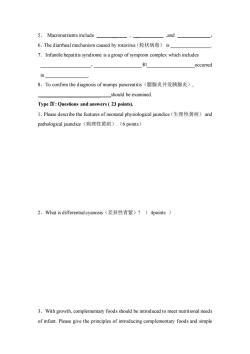
Macronutrients includeand6. The diarheal mechanism caused by rotavirus(轮状病毒)is7.Infantile hepatitis syndrome is a group of symptom complex which includesoccurred8.To confirm thediagnosis ofmumps pancreatitis(腮腺炎并发胰腺炎)should be examined.Type IV: Questions and answers ( 23 points).1.Please describe thefeaturesof neonatal physiological jaundice(生理性黄痘)andpathological jaundice(病理性黄疽)(6points)2.Whatisdiferentalcyanosis(差异性青紫)?(4points)3.With growth, complementaryfoods should be introduced to meetnutritional needsof infant. Please give the principles of introducing complementary foods and simple
5. Macronutrients include _ , _ ,and 。 6.The diarrheal mechanism caused by rotavirus(轮状病毒) is _. 7.Infantile hepatitis syndrome is a group of symptom complex which includes _,_和_occurred in _. 8.To confirm the diagnosis of mumps pancreatitis(腮腺炎并发胰腺炎), _ should be examined. Type Ⅳ: Questions and answers ( 23 points). 1.Please describe the features of neonatal physiological jaundice(生理性黄疸) and pathological jaundice(病理性黄疸).(6 points) 2.What is differential cyanosis(差异性青紫)? ( 4points ) 3.With growth, complementary foods should be introduced to meet nutritional needs of infant. Please give the principles of introducing complementary foods and simple
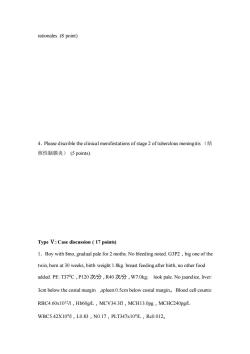
rationales. (8 point)4. Please discrible the clinical menifestations of stage 2 of tuberclous meningitis(结核性脑膜炎)(5 points).Type V : Case discussion (17 points)1. Boy with 8mo, gradual pale for 2 moths. No bleeding noted.G3P2, big one of thetwin, born at 30 weeks, birth weight 1.8kg. breast feeding after birth, no other foodadded.PE:T370C,P120次/分,R40次/分,W7.0kg,look pale.No jaundice,liver3cm below the costal margin spleen:0.5cm below costal margin。Blood cell counts:RBC4.60x1012/,Hb60g/L,MCV34.3fl,MCH13.0pg,MCHC240pg/LWBC5.42X10%/,L0.83,NO.17,PLT347x10/L,Rc0.012
rationales. (8 point) 4.Please discrible the clinical menifestations of stage 2 of tuberclous meningitis (结 核性脑膜炎) (5 points). Type Ⅴ: Case discussion ( 17 points) 1.Boy with 8mo, gradual pale for 2 moths. No bleeding noted. G3P2,big one of the twin, born at 30 weeks, birth weight 1.8kg. breast feeding after birth, no other food added. PE: T370C,P120 次/分,R40 次/分,W7.0kg; look pale. No jaundice, liver: 3cm below the costal margin ,spleen:0.5cm below costal margin。Blood cell counts: RBC4.60x1012/l,Hb60g/L,MCV34.3fl,MCH13.0pg,MCHC240pg/L WBC5.42X109 /l,L0.83,N0.17,PLT347x109 /L,Rc0.012
按次数下载不扣除下载券;
注册用户24小时内重复下载只扣除一次;
顺序:VIP每日次数-->可用次数-->下载券;
- 《儿科学》课程作业习题(试卷和答案)双语试卷C卷(试题).doc
- 《儿科学》课程作业习题(典型病例)02 pneumonia.doc
- 《儿科学》课程作业习题(典型病例)01 ABO incompatibility of neonates.doc
- 《儿科学》课程作业习题(典型病例)03 congenital heart disease-TOF.doc
- 《儿科学》课程作业习题(典型病例)07 congenital hypothyroidism.doc
- 《儿科学》课程作业习题(典型病例)05 purulent meningitis.doc
- 《儿科学》课程作业习题(典型病例)04 iron deficiency anemia.doc
- 《儿科学》课程作业习题(典型病例)03 congenital heart disease-VSD.doc
- 《儿科学》课程作业习题(典型病例)08 diarrhea.doc
- 《儿科学》课程作业习题(典型病例)06 anute nepheritis-1.doc
- 《儿科学》课程作业习题(典型病例)06 nephrotic syndrome-2.doc
- 《儿科学》课程作业习题(复习题)01 questions of children healthcare.doc
- 《儿科学》课程作业习题(复习题)02 questions of neonatal diseases.doc
- 《儿科学》课程作业习题(复习题)05 questions of blood disorders.doc
- 《儿科学》课程作业习题(复习题)04 questions of circulatory system.doc
- 《儿科学》课程作业习题(复习题)03 questions of respiratory diseases.doc
- 《儿科学》课程作业习题(复习题)06 questions of nervous system.doc
- 《儿科学》课程作业习题(复习题)10 questions of infectious diseases.doc
- 《儿科学》课程作业习题(复习题)09 questions of endocrine disorders.doc
- 《儿科学》课程作业习题(复习题)07 questions of urinological system.doc
- 《儿科学》课程作业习题(试卷和答案)双语试卷B卷(答案).doc
- 《儿科学》课程作业习题(试卷和答案)双语试卷C卷(答案).doc
- 《儿科学》课程作业习题(试卷和答案)双语试卷A卷(试题).doc
- 《儿科学》课程作业习题(试卷和答案)双语试卷A卷(答案).doc
- 《儿科学》课程教学课件(PPT讲稿)07 新生儿缺氧缺血性脑病 Hypoxic-ischemic Encephalopathy(HIE).pptx
- 《儿科学》课程教学课件(PPT讲稿)06 新生儿败血症 Neonatal Septicemia.pptx
- 《儿科学》课程教学课件(PPT讲稿)21 Chronic Gastritis in Children.pptx
- 《儿科学》课程教学课件(PPT讲稿)20 Toxic Bacillary Dysentery.pptx
- 《儿科学》课程教学课件(PPT讲稿)27 Inflammation Causes Cholesterol Redistribution by Diverting Cholesterol from Circulation to Tissue Tompartments.pptx
- 《儿科学》课程教学课件(PPT讲稿)26 Rotavirus Infection in Children.pptx
- 《儿科学》课程教学课件(PPT讲稿)25 Scarlet Fever.pptx
- 《儿科学》课程教学课件(PPT讲稿)24 Mumps(Epidemic parotitis).pptx
- 《儿科学》课程教学课件(PPT讲稿)23 Infantile Hepatitis Syndrome.pptx
- 《儿科学》课程教学课件(PPT讲稿)22 Infantale Diarrhea and Fluid Therapy.pptx
- 《儿科学》课程教学课件(PPT讲稿)19 Pediatric Tuberculosis.pptx
- 《儿科学》课程教学课件(PPT讲稿)18 Varicella.pptx
- 《儿科学》课程教学课件(PPT讲稿)17 Measles.pptx
- 《儿科学》课程教学课件(PPT讲稿)16 Growth Hormone Deficiency.pptx
- 《儿科学》课程教学课件(PPT讲稿)15 Congenital Hypothyroidism.pptx
- 《儿科学》课程教学课件(PPT讲稿)14 Immunodeficiency.pptx
